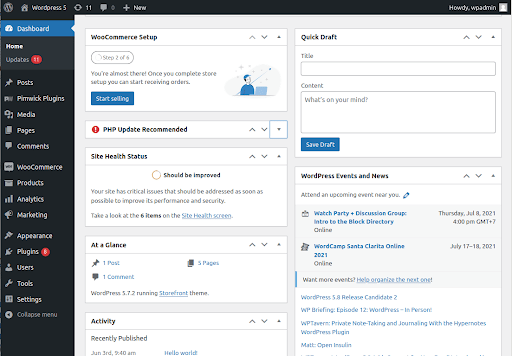
5G is a generation of mobile communications based on 5G/IMT-2020 telecommunications standards that offer higher bandwidth than 4G, as well as low latency, speeds up to 2 Gbps, and improved energy efficiency. If you are still in doubt about the need to install a private 5G network for your business, then this article is for you. We will look at the main differences between 4G and 5G.
Table of Contents
How 4G And 5G Work
If we put 5G vs 4G on the scales, then it’s worth starting from the very basics. The entire radio spectrum is divided into frequency bands, each of which has its own characteristics. With increasing frequency, the capacitive indicators of the mobile network and the data transfer rate in it increase, as well as the congestion decreases and the directionality increases. The higher the frequency, the less it is negatively affected by extraneous radio signals transmitted in parallel, which means that distortion and the amount of noise are reduced, which has a positive effect on quality: delays are minimised, and transmission accuracy reaches a higher level.
The 4th generation includes a range of up to 6 GHz, but the 5th generation already uses from 30 to 300 GHz. 4G base stations spread the signal in all directions even when it is not required, so some of the energy is wasted, but they cover a larger area. 5G towers are characterised by a smaller radius, smaller size, and precise directionality, which allows them to be more efficient, including in terms of power consumption. Due to the smaller size of the antenna, more antennas can be installed on the tower, which means that it will be possible to provide a greater number of connections. A huge advantage of 5G networks is the flexibility to adapt to the transmitted content. Depending on how much traffic is used, the cell tower can regulate its power consumption.
Difference Between 5G And 4G In Speed And New User Needs
Let’s consider 5G and 4G private networks in terms of speed performance. Here the 5th generation undoubtedly wins, since theoretically, its speed is 20 times higher (20 Gb / s versus 1 Gb / s in ideal conditions and when the connected devices are stationary). In reality, everything looks a little different, since there are a lot of factors affecting the final speed. It is also difficult to give exact numbers for 5G because the accumulated experience with networks of this generation is much less. The minimum download speed that 4G demonstrates is on average 10 Mbps, while the 5th generation of communication has never shown a value less than 100 Mbps. That is, even under adverse conditions, one can judge at least a 10-fold advantage, and this is impressive. In the confrontation between 5G vs 4G, it is new technologies that win.
The modern world has already outgrown the speed that 4G networks provide. Traffic consumption per unit of time is constantly growing. This is due to the rapid development of the Internet environment and the range of opportunities that it provides. And if in the performance of everyday tasks for an ordinary user this is not yet so noticeable, then in the business sphere and large projects, the lack of speed is already felt quite acutely.
For example, let’s take 4K video, which has become the standard for high quality. The average speed of 4G LTE in European countries is 30 Mbps. To watch a 4K video, you need a speed of at least 25 Mbps, and ideally even from 45 Mbps, since only then you can count on the absence of freezes or slowdowns. That is, theoretically, viewing through 4th generation networks is possible, but in reality, the mobile Internet is rarely used by the user solely for one action, it is simply impractical to connect to it only to view this format. There are always other tasks that require their share of speed and traffic. Yes, and 45 Mbps can be obtained far from everywhere, which means that for many users, viewing content in 4K through 4th generation networks is still inaccessible.
If we consider the technologies of machine-to-machine interaction, unmanned control, industrial automation, virtual and augmented reality, and the Internet of things, then 4G technologies are no longer able to fully satisfy their high-speed needs.
Applications For 5G
Considering the difference between 5G and 4G, we simply cannot but touch upon the topic of the prospects that open up with the introduction of a new generation of communications. The fifth standard will allow you to do everything that is already done using the fourth, but more comfortably:
- file sharing
- media upload
- transferring large content.
With the fifth standard, games will stop slowing down, and high-quality videos, including video calls, will run smoothly and look more realistic. In addition, 5G will make it easy to connect more devices without a significant drop in speed and use even in the home space those technologies that were previously unavailable.
As for non-domestic use, the widest development opportunities open up here:
- organisation of factories and industries of the future with higher levels of safety and efficiency;
- provision of quality medical services in rural areas;
- the emergence of unmanned vehicles;
- improvement of the ecological situation;
- improving the work of emergency services;
- the emergence of smart cities and much more.
The prospects for the introduction of 5G are huge and will bring life to a new, higher level in many areas.
Final Thoughts
5G is the fifth-generation mobile communication network that replaced 4G LTE. The new communication standard is characterised by improved data transfer rates, coverage quality, network stability, and capacity. As in previous cellular networks, the new standard supports a full range of telecommunications services: the Internet, voice and video calls, SMS, etc. We recommend that you contact UCtel if you want to upgrade to 5G and enjoy improved connectivity. The company provides services to install and maintain an excellent signal for both 4G and 5G private networks. You can also get high-quality assistance in strengthening the signal in places with a hard-to-reach communication signal.
RELATED ARTICLES
Latest Articles
 Mastering the Art of Machine Vision: Choosing the Perfect Lens for Optimum PerformanceIn TechnologyMay 2, 2024Key Takeaways: Machine vision is a technology that […]
Mastering the Art of Machine Vision: Choosing the Perfect Lens for Optimum PerformanceIn TechnologyMay 2, 2024Key Takeaways: Machine vision is a technology that […] Unlocking Success: Mastering Bank PO Interview PreparationIn EducationApril 24, 2024For banking careers, PO interviews stand as formidable […]
Unlocking Success: Mastering Bank PO Interview PreparationIn EducationApril 24, 2024For banking careers, PO interviews stand as formidable […] The Strategic Value of Purchasing FontsIn TipsApril 18, 2024In today’s visually driven world, fonts are more […]
The Strategic Value of Purchasing FontsIn TipsApril 18, 2024In today’s visually driven world, fonts are more […] Revolutionizing Business: How AI Transforms Customer Experience in the Inflatable IndustryIn BusinessApril 16, 2024Inflatable water slides are the epitome of summer fun, […]
Revolutionizing Business: How AI Transforms Customer Experience in the Inflatable IndustryIn BusinessApril 16, 2024Inflatable water slides are the epitome of summer fun, […] Most Asked Microservice Interview Questions For 2024In TechnologyApril 2, 2024To keep up with changing trends in the tech industry […]
Most Asked Microservice Interview Questions For 2024In TechnologyApril 2, 2024To keep up with changing trends in the tech industry […] Best JavaScript and CSS Library In 2024In TechnologyApril 2, 2024With the ever-expanding functionality of web […]
Best JavaScript and CSS Library In 2024In TechnologyApril 2, 2024With the ever-expanding functionality of web […] Front-End Development Trends to Follow in 2024In TechnologyApril 2, 2024For better engagement, the front-end development of […]
Front-End Development Trends to Follow in 2024In TechnologyApril 2, 2024For better engagement, the front-end development of […] Simplifying Mealtime: Meal Prepping for a Family of FourIn UncategorizedMarch 22, 2024In the hustle and bustle of daily life, planning and […]
Simplifying Mealtime: Meal Prepping for a Family of FourIn UncategorizedMarch 22, 2024In the hustle and bustle of daily life, planning and […] How to Freeze Dry Candy With And Without a Machine?In FoodFebruary 27, 2024A candy lover constantly searches for novel and […]
How to Freeze Dry Candy With And Without a Machine?In FoodFebruary 27, 2024A candy lover constantly searches for novel and […] How to Get Something Out Of Your Eye Immediately?In healthFebruary 27, 2024Getting something inside your eyes can be frustrating […]
How to Get Something Out Of Your Eye Immediately?In healthFebruary 27, 2024Getting something inside your eyes can be frustrating […] The Evolution of Remote Control Technology: From RC Cars to DronesIn TechnologyFebruary 22, 2024Remote control technology has come a long way since […]
The Evolution of Remote Control Technology: From RC Cars to DronesIn TechnologyFebruary 22, 2024Remote control technology has come a long way since […] Unveiling the most popular carnival costumes: A colorful parade of creativityIn FashionFebruary 19, 2024In the world of festivities and merrymaking, few […]
Unveiling the most popular carnival costumes: A colorful parade of creativityIn FashionFebruary 19, 2024In the world of festivities and merrymaking, few […]
stopie.com is a participant in the Amazon Services LLC Associates Program, an affiliate advertising program designed to provide a means for sites to earn advertising fees by advertising and linking to Amazon.com.
Clicking on an Amazon link from stopie.com does not increase the cost of any item you purchase.
We will only ever link to Amazon products that we think our visitors may be interested in and appreciate learning more about.



